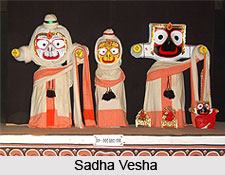 Costumes of Lord Jagannath are beautiful to behold. They are symbolic of the religious as well as cultural synthesis in the shrine. The deities are dressed in Cotton and silk fabrics. They are adorned with beautiful gold ornaments which are studded with stones, various kinds of flowers, sandal paste, Tulsi leaves and camphor. These articles are used in the daily as well as the periodical rituals that are held. The deities are dressed by the sevaks of the temple known as Puspalaks or Singharis. The various costumes worn by the lord are discussed below.
Costumes of Lord Jagannath are beautiful to behold. They are symbolic of the religious as well as cultural synthesis in the shrine. The deities are dressed in Cotton and silk fabrics. They are adorned with beautiful gold ornaments which are studded with stones, various kinds of flowers, sandal paste, Tulsi leaves and camphor. These articles are used in the daily as well as the periodical rituals that are held. The deities are dressed by the sevaks of the temple known as Puspalaks or Singharis. The various costumes worn by the lord are discussed below.
Abakasha (Tadapa uttari) Vesha
This Vesha is done every morning every morning after the Mangal Aarti for the rituals of Abakash. During this time the deities wear the garments known as the "Tadapa" and "Uttariya". The Tadapa is like a napkin which is a white an orange colour border cloth. The Uttariya is like a salwar. After this dressing the ritual bath follows. The colour of the dress changes everyday to remind the deities of the supremacy of the Lord and his mastery over the planets. So Sunday to Saturday He wears seven different coloured dresses- Red on Sunday, White with Black spotted on Monday, a dress with a mixture of five different colours on Wednesday, Yellow dress on Thursday, white dress on Friday and Black Dress on Saturday.
Sadha Vesha
The Sadha Vesha comprises the normal costumes of deities which is worne five different times in a day .This is especially so after an offering is made. This particular Vesha consists of flower garlands and clothes of silk.
Bada Sringar Vesha
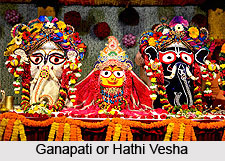 This Vesha is what the deity is adorned with every night at the time of going to sleep. This Vesha is made up mainly of flowers of different colours and species. The deities are made to wear silken dresses called `Khandua`. The next morning, the offering of the lamp is made to the deity in this costume. Within the fabric of this khandua extract from the famous Sanskrit language poem of Jayadeva, Geet Gobinda is woven extract.
This Vesha is what the deity is adorned with every night at the time of going to sleep. This Vesha is made up mainly of flowers of different colours and species. The deities are made to wear silken dresses called `Khandua`. The next morning, the offering of the lamp is made to the deity in this costume. Within the fabric of this khandua extract from the famous Sanskrit language poem of Jayadeva, Geet Gobinda is woven extract.
Chandan Vesha
The Chandan Vesha starts from Akshaya Tritya day and from then on is done for 42 days. During this time, sandal paste oil is applied on the body of the deity and it is decorated with flowers. The first 21 days starting from Akshaya Tritya are known as the outer Chandan Yatra and the remaining 21 days are known as the inner Chandan Yatra.
Ganapati or Hathi vesha
In the month of Jayestha on the full moon day, the deities are dressed up as elephants following the bathing ceremony. Lord Jagannath and Lord Balabhadra are made to appear like Lord Ganesha. Black materials for the dressing are provided by the Gopal Tirtha Mathaand Ragabdas Math of Puri.
Suna (gold) vesha
The Suna vesha ia also known as the Bada Tadhau vesha. It takes place on the 11th day in the fortnight of Ashada. At this time the deities are in their respective ornaments near the Lion`s Gate of the Sree Jagannath temple. The deities are decorated with gold ornaments. Lord Jagannath and Balabhadra have hands and feet made of gold. Lord Jagannath can be seen holding a Chakra in his right hand and a silver conch in the left hand. Lord Balabhadra is seen with a gold plough in the left hand and a gold mace in the right hand. This kind of golden-ornaments decoration is also done on festivals like Dashahara, Kartika Purnima and Pausa purnima.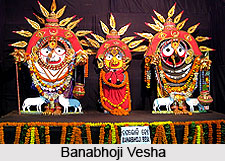
Banabhoji Vesha
Thus Vesha is done on the 10th day of the dark fortnight of Bhadraba. The deities are dressed as cowherd boys, as if they are going for a picnic. The reason behind this is that it has been said in the Krishnalila that Lord Krishna had gone for a picnic to the forest with his elder brother Balarama and a group of cows. Keeping this in mind the idol is dressed in this particular vesha.
Kaliyadalana Vesha
On the 11th day of the dark fortnight of Bhadraba, Lord Jagannath is dressed like Lord Krishna killing the Kaliya Serpent.
Pralambasura Badha Vesha
This vesha depicts the killing of the demon Pralambasura is depicted in this Vesha. It is done on the 12th day of the dark fortnight of Vesha.
Krishna Balarama Vesha
This vesha is done on the 13th day of the dark fortnight of Bhadraba. During this time, Lord Jagannath and Balabhadra are dressed like Lord Krishna and Balaram. This vesha has been continued in the Sriram mandir since the 16th century, as has been mentioned in the Madala Pariji.
Bali Baman Vesha
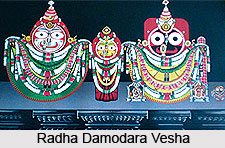 On the 12th day of the bright fortnight of Bhadraba, Lord Jagannath is dressed like "Vamana". He was a dwarf-Brahmin who pressed the demon King Bali to Patal, beneath the earth. Vamana avatar is the fifth incarnation of Lord Vishnu.
On the 12th day of the bright fortnight of Bhadraba, Lord Jagannath is dressed like "Vamana". He was a dwarf-Brahmin who pressed the demon King Bali to Patal, beneath the earth. Vamana avatar is the fifth incarnation of Lord Vishnu.
Radha Damodara Vesha
This Vesha takes place from the 11th day of the bright fortnight of Ashwin and continues till the 10th day of the bright fortnight of Kartika. Lord Jagannath is decorated as Damodar (Krishna) during these days.
Thiakia(Laxmi-Narayan) Vesha
It is done on the 11th day of the bright fortnight of Kartika. The deities are decorated in this Vesha after the abhishek. The deities are also decorated with gold ornaments. They are made to wear beautiful golden crowns on their heads. In this vesha, Lord Jagannath can be seen holding a silver conch shell and the sudarshan chakra made of gold. Lord Balabhadra holds plough and shovel. This vesha is very dear to a caste of devotees known as the Bishishta daityabad.
Bankachula Vesha
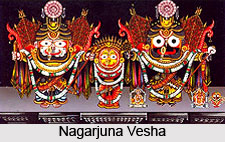 It is done on the 12th day of the bright fortnight of Kartika. The deities are decorated with gold ornaments. This vesha has been continuing since ancient times in memory of the time when Akrur came to Gopa from Mathura to take Sri Krishna by the order of king Ansha, and during this time he saw the Lord adorned in the Banka-chula vesha. In this vesha, Lord Jagannath and Lord Balabhadra are decorated with the chandanika-chula on the left side, a braid on top and a golden kia placed on the forehead of Lord Jagannath. A small crown is also worn by the deity. This vesha is held dear by the devotees of the Atibari caste.
It is done on the 12th day of the bright fortnight of Kartika. The deities are decorated with gold ornaments. This vesha has been continuing since ancient times in memory of the time when Akrur came to Gopa from Mathura to take Sri Krishna by the order of king Ansha, and during this time he saw the Lord adorned in the Banka-chula vesha. In this vesha, Lord Jagannath and Lord Balabhadra are decorated with the chandanika-chula on the left side, a braid on top and a golden kia placed on the forehead of Lord Jagannath. A small crown is also worn by the deity. This vesha is held dear by the devotees of the Atibari caste.
Adakia(Tribikrama) Vesha
This is done on the 13th day of the bright fortnight of Kartika. In this vesha the Lord can be seen wearing a heroic dress with a golden sword, a wheel, conch shell, a club and a golden crown on the head with a kia.
Dalikia Vesha
Also known as the Laxmi-Narisimha Vesha, this vesha is done on the 14th day of the bright fortnight of Kartika. On this day the Lord is dressed in golden ornaments as half a lion in celebration of his incarnation as Satya Yuga. He is adorned with a Venda chula and golden kia.
Nagarjuna Vesha
The Nagarjuna Vesha is done occasionally in the month of Kartika, when there are six days of Panchaka. The lords are dressed like warriors.
Ghodalagi Vesha
The deities are made to wear winter clothes in the period from the 6th day of the bright fortnight of Margasira to the 5th day of the bright fortnight of Magha (Basanta Panchami). Except for their faces, the deities are covered completely in velvet.
Jamalagi Vesha
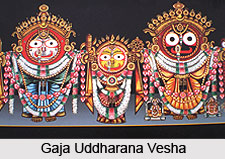 Starting from Vasant Panchami to Dola Purnima, the deities are made to wear modified winter clothes. All these jamas (shirts) are made of silk colour cloth. During this time, the deities are made to wear 4 pieces of patas and 30 pieces of gold ornaments.
Starting from Vasant Panchami to Dola Purnima, the deities are made to wear modified winter clothes. All these jamas (shirts) are made of silk colour cloth. During this time, the deities are made to wear 4 pieces of patas and 30 pieces of gold ornaments.
Padma Vesha
This vesha is done on any Saturday or Wednesday between the new moon day of Magha and Vasant Panchami. "Padma" means lotus. The dress materials for this vesha are made of lotus flower, bud of lotus prepared with sola sraft, silver, golden threads, plant Whread, cotton cloth, gum of wood apple and colours. This vesha has been continuing in the Sree Mandir since the last three hundred years. The vesha materials are supplied by the `Badachata Matha`. The entire decoration of this vesha is done by skilled artists. This vesha is done at the time of Bada Singhar of the deities, the only time when the deities go to sleep in this vesha.
Gaja Uddharana Vesha
The Gaja Vesha is done on the full moon day of Magha. It actually depicts a story in the Puranas about how Lord Vishnu saved an elephant from the attack of an Alligator on Baruna Lake. This vesha has been celebrated in the Sree Mandir for a long period of time, and in fact some devotees believe that this vesha is holding in Sri Mandira by the king Ramchandra Dev on 1575. The material used for the vesha is made of Sola craft. The Lord Jagannath is seen sitting on the Garuda. The elephant and crocodile are in a fighting position in the water under Ratnavedi.
Besides these, there are other veshas like Shradha and Chacheri veshas which are done in the month of Margasira and Falguna respectively, Nabank Vesha, Harihara Vesha, Navayoban Vesha and Chita Lagi Ambasya Vesha. All these different veshas are done at different points in time in the year and serve to beautify and adorn the idol of the Lord.









